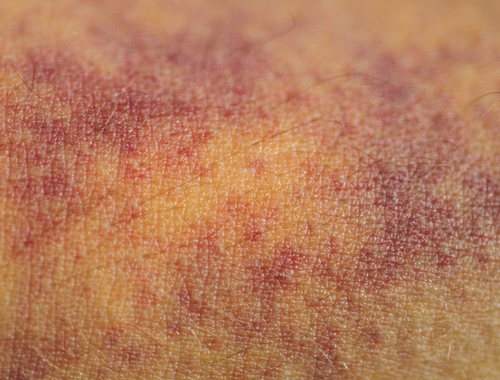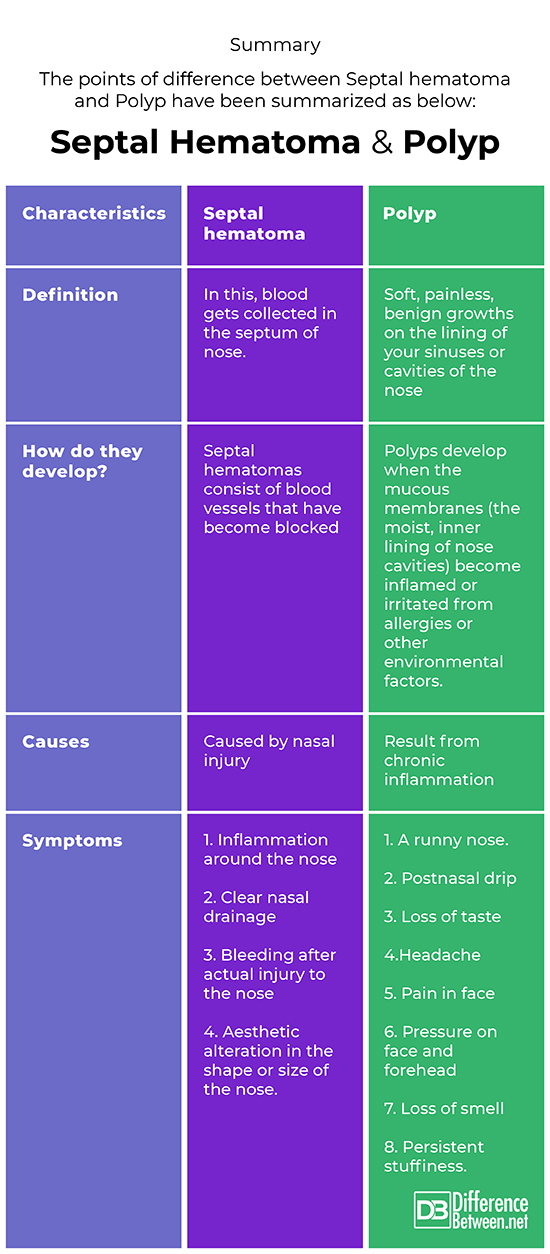Difference Between Septal Hematoma and Polyp

What is septal hematoma and polyp?
A septal hematoma is the accumulation of blood that forms outside of the blood vessels, in the area between the layers of tissue surrounding the nasal cavity. A septal polyp, on the other hand, is an enlargement originating from these lining tissues and protruding into this inter-tissue region. Both conditions could induce related symptoms such as a congested nose, breathing troubles and a sensation of weight on the affected area. To deal with a septal hematoma, draining off the blood is generally needed. As for a septal polyp, it may need surgical extraction.

Similarity
In both medical conditions, there is presence of excess fluid in the nose.
Septal hematoma
A nasal septal hematoma is an accumulation of blood within the septum (a partition separating cavity of the nostrils) of the nose, the section between the nostrils. An injury disrupts the blood vessels, causing fluid and blood to collect under the lining. Normally, the nasal septum is rigid and thin. If you have a septal hematoma, your general practitioner will be able to see discoloration, bruises and press it down with a swab since the affected area will be soft. They can also examine your nose to see if there are any swellings.
Polyp
Polyps are benign growths in the nasal passages and sinuses (a cavity within a bone or other tissue), vacant spaces in the bones around your nose. They form from mucous membranes, thin, soft tissues that line these cavities. In some cases, nasal polyps can become inflamed and swollen, partially blocking nasal passages and sinuses.
Difference between Septal hematoma and Polyp
Definition
Septal hematoma
Collection of blood between the perichondrium (a dense layer of fibrous connective tissue covering cartilage surface in the body) of nasal septum and the septal cartilage.
Polyp
Soft and painless benign growth on the lining of sinuses or nasal cavity (passages)
Symptoms
Septal hematoma
Septal hematomas can also cause the following symptoms:
- Breathing through your nose is difficult
- Nose shape changes
- Bruising
- Issues in breathing through nose
People with septal hematomas may sometimes experience the following symptoms:
- Throwing up
- Anxiety
- Nausea
- fainting
Polyp
- Cause more diffused nasal congestion and obstruction
- Loss of taste and smelling
- Nosebleeds
- Stuffy nose
- Headaches
- Nasal drainage (runny nose)
- Snoring
- Postnasal drip
- Pain or pressure in the sinuses, face or top teeth.
Causes
Septal hematoma
The most common type of trauma to the face that causes septal hematomas is nasal injury. Injuries to the soft tissues, surgery, or broken nose are all common causes of septal hematomas. Children are more likely to have the condition because their septum’s are thicker and more flexible.
Polyp
When people are in their thirties or forties, nasal polyps tend to develop. They’re often caused by inflammation in the nose, such as:
- Symptoms of allergic rhinitis (hay fever) (caused by the immune system reacting to an allergen or other allergies, such as to aspirin or fungus.
- Asthma
- Chronic rhinosinusitis (CRS) (an inflammatory disorder of the paranasal sinuses and linings of the nasal passages)
- The disease of cystic fibrosis
- Infections of the sinuses or other infections that occur repeatedly.
Treatment
Septal hematoma
Hematoma is incised, drained, and packed to prevent recurrence. Small incisions happen through the mucoperichondrium to evacuate or drain the collected blood
Polyp
Nasal corticosteroids – drugs that can make even large polyps shrink or disappear.
Prevention
Septal hematoma
Avoid breathing in airborne contaminants such allergies, tobacco smoke, chemical fumes, dust, and tiny debris that could cause swelling or inflammation in your nose and sinuses.
Polyp
Nasal sprays, allergy injections, antihistamines, may help prevent polyps that block your airway.
Summary
The points of difference between Septal hematoma and Polyp have been summarized as below:

FAQ
How do you rule out a septal hematoma?
Doctor will examine your nose to see if there is inflammation of the tissue between the nostrils. He will touch that swelled area with a cotton swab. If there is a hematoma (a bad bruise), the swelled area will be soft and able to be pressed down. The nasal septum is normally thin and rigid.
What is a nasal septal hematoma?
Nasal septal hematomas occur when blood accumulates under the septum of the nose. The septum is the part of the nose between the nostrils. When the blood vessels are disrupted, fluid and blood accumulate under the septum.
What is a deviated septum and polyps?
When there is obstruction of one or both the nostrils, it is called deviated septum. And when you have a deviated septum, you may be more at the risk of nasal blockage, which could further result in development of nasal polyps.
What does septal hematoma feel like?
Soft and unstable in contrast to deviated nasal septum (Sideways displacement of the wall between the nostrils) which will be firm and concave (hollow) on the opposite side.
Should I go to the ER for a septal hematoma?
If there is a delayed diagnosis and treatment of septal hematoma, that can result in aesthetic alterations (the physical change of the outside appearance of nose) related to local absorption of necrotic septal cartilage (the death of body tissue of the septum), as well as intracranial (tumor that occurs in the brain) complications like subarachnoid empyema (loculated collection of pus in the subdural space between the dura mater and the arachnoid), brain abscess (a pus-filled swelling in the brain), and meningitis (an infection and inflammation of the fluid and membranes surrounding the brain and spinal cord)
How long can septal hematoma last?
To prevent avascular necrosis of the septal hyaline cartilage, septal hematomas must be incised and drained. In most cases, the septum heals within 1 week, with no visible signs of the incision. This will depend on diffusion of nutrients from the nasal mucosa.
- Difference Between Global Warming and Greenhouse Effect - May 18, 2024
- Difference Between Vaccination and Immunization - March 3, 2024
- Difference Between Selective Mutism and Autism - February 25, 2024
Search DifferenceBetween.net :
Leave a Response
References :
[0]Drake-Lee, A. B. (2004). Nasal polyps. Hospital Medicine, 65(5), 264-267.
[1]Fokkens, W., Lund, V., & Mullol, J. (2007). European position paper on rhinosinusitis and nasal polyps 2007. Rhinology. Supplement, 20, 1-136.
[2]Gupta, G., & Mahajan, K. (2022). Nasal Septal Hematoma. StatPearls [Internet].
[3]Sayn, I., Yazc, Z. M., Bozkurt, E., & Kayhan, F. T. (2011). Nasal septal hematoma and abscess in children. Journal of Craniofacial Surgery, 22(6), e17-e19.
